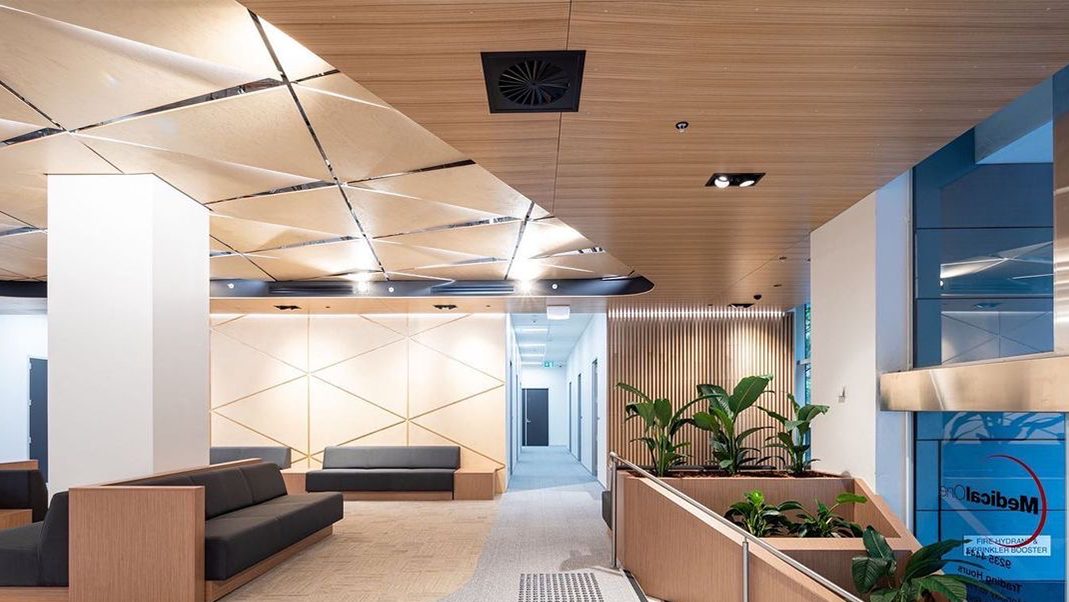16—01—2023
6 Top Tips When Installing Plywood Panels
It’s no secret that ply panels bring something special to interiors – the natural beauty of the timber and endless design possibilities allow you to create a truly memorable space. To achieve your desired look and feel, the specification and finish of the ply product is obviously critical – however, an often overlooked aspect which is arguably just as important is getting the installation of your ply panels right.
Walls or ceilings featuring ply panelling can either look spectacular or subpar depending on the installation method used and whether all of the specific details have been carefully considered and executed well.
So to help you get the best result for your next project, our team have put together a list of 6 expert tips and key considerations when installing ply panels.
Plan the layout and fixings
The first aspect you’ll need to consider is the layout of your panels, as this will have a significant impact on the end result. When specifying the layout, keep in mind that the panels generally look best when centered to the wall or ceiling, as this brings a sense of symmetry to the space.
Depending on the specified layout of the panels, having suitable studs or joists in the right places is a must, in order to be sure the panels are adequately fixed to the structure. This is especially important where there are express gaps in the design.
Finish the edges for longevity
While we understand that for many projects the edges of ply often aren’t sealed, we highly recommend that you do so. Finishing the edges will protect the longevity and durability of the boards, so they look better for longer. In contrast, should you choose to leave the edges unfinished, it can allow moisture to get into the panels, causing them to discolor over time or even bow. Sealing the edges is particularly important for any projects that highlight express joins.
Acclimatising the panels effectively prior to installing
The ability for ply to breathe is paramount, and being a natural product, it does need to acclimatise to its surroundings for at least 48 hours prior to pre-finishing the edges and installing. For the best results, you must also ensure that the boards are stored completely flat at all times, including while they are cut on site and the edges are sealed, prior to installation.
Avoid exposure to direct weather or direct sunlight
It’s essential that you protect your plywood panels from the elements at all times. This means if your building is not yet at lockup stage, you’ll need to arrange for adequate coverage to avoid exposure to direct weather or direct sunlight. Leaving your ply panels for any length of time unprotected and exposed to the elements can cause damage such as fading, discoloration or bowing.
Ambient temperature and ventilation of the space
The optimal environmental temperature for timber is generally between 5–25 degrees Celsius. Keep in mind that humidity should also be controlled, and that anything outside this range can have an adverse effect on the timber panels. For example, a space with high exposure to sunlight can cause a room to overheat, which can then lead to the panels potentially bowing over time.
If your space has a lack of ventilation, combined with high temperatures, we recommend you pay extra attention to the fixing of your timber panels. We suggest all panels are directly fixed to a sound structure and spanned every 400mm (at least) to avoid the panels from warping and bowing.
The fixing method plays a major role in getting the installation right
We offer a range of different installation methods for walls and ceilings, and choosing the right option is a critical aspect of success when installing. It is also paramount to be sure that all fixings are close to the edges and corners of each panel, so that your panels are secure where it counts.
Talk to us for expert installation advice
As you can see, there are many considerations to be aware of when installing ply panels. From layout and fixing, to the right environment and correct storage, each aspect plays an important role in delivering the best result. In addition, not following the above advice could potentially void your Maxiply warranty on the ply panels, so be sure you are clear on what needs to be done before you start.
And remember, installing ply panels is not limited to the above points. Ply in its natural form, has the ability to behave in unexplained ways, which is why we recommend contacting our expert team on 1300 761 741 or at [email protected] if you have any questions or need advice regarding the correct installation of your panels.

16—01—2023
It’s no secret that ply panels bring something special to interiors – the natural beauty of the timber and endless design possibilities allow you to create a truly memorable space. To achieve your desired look and feel, the specification and finish of the ply product is obviously critical – however, an often overlooked aspect which is arguably just as important is getting the installation of your ply panels right.
Walls or ceilings featuring ply panelling can either look spectacular or subpar depending on the installation method used and whether all of the specific details have been carefully considered and executed well.
So to help you get the best result for your next project, our team have put together a list of 6 expert tips and key considerations when installing ply panels.
Plan the layout and fixings
The first aspect you’ll need to consider is the layout of your panels, as this will have a significant impact on the end result. When specifying the layout, keep in mind that the panels generally look best when centered to the wall or ceiling, as this brings a sense of symmetry to the space.
Depending on the specified layout of the panels, having suitable studs or joists in the right places is a must, in order to be sure the panels are adequately fixed to the structure. This is especially important where there are express gaps in the design.
Finish the edges for longevity
While we understand that for many projects the edges of ply often aren’t sealed, we highly recommend that you do so. Finishing the edges will protect the longevity and durability of the boards, so they look better for longer. In contrast, should you choose to leave the edges unfinished, it can allow moisture to get into the panels, causing them to discolor over time or even bow. Sealing the edges is particularly important for any projects that highlight express joins.
Acclimatising the panels effectively prior to installing
The ability for ply to breathe is paramount, and being a natural product, it does need to acclimatise to its surroundings for at least 48 hours prior to pre-finishing the edges and installing. For the best results, you must also ensure that the boards are stored completely flat at all times, including while they are cut on site and the edges are sealed, prior to installation.
Avoid exposure to direct weather or direct sunlight
It’s essential that you protect your plywood panels from the elements at all times. This means if your building is not yet at lockup stage, you’ll need to arrange for adequate coverage to avoid exposure to direct weather or direct sunlight. Leaving your ply panels for any length of time unprotected and exposed to the elements can cause damage such as fading, discoloration or bowing.
Ambient temperature and ventilation of the space
The optimal environmental temperature for timber is generally between 5–25 degrees Celsius. Keep in mind that humidity should also be controlled, and that anything outside this range can have an adverse effect on the timber panels. For example, a space with high exposure to sunlight can cause a room to overheat, which can then lead to the panels potentially bowing over time.
If your space has a lack of ventilation, combined with high temperatures, we recommend you pay extra attention to the fixing of your timber panels. We suggest all panels are directly fixed to a sound structure and spanned every 400mm (at least) to avoid the panels from warping and bowing.
The fixing method plays a major role in getting the installation right
We offer a range of different installation methods for walls and ceilings, and choosing the right option is a critical aspect of success when installing. It is also paramount to be sure that all fixings are close to the edges and corners of each panel, so that your panels are secure where it counts.
Talk to us for expert installation advice
As you can see, there are many considerations to be aware of when installing ply panels. From layout and fixing, to the right environment and correct storage, each aspect plays an important role in delivering the best result. In addition, not following the above advice could potentially void your Maxiply warranty on the ply panels, so be sure you are clear on what needs to be done before you start.
And remember, installing ply panels is not limited to the above points. Ply in its natural form, has the ability to behave in unexplained ways, which is why we recommend contacting our expert team on 1300 761 741 or at [email protected] if you have any questions or need advice regarding the correct installation of your panels.






